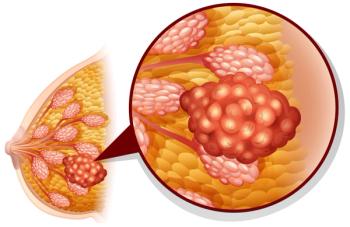
Loncastuximab Tesirine Plus Ibrutinib in Relapsed DLBCL Trends Favorably at LOTIS-3 Interim Analysis
Anti-tumor activity coupled with a manageable safety profile was noted with the combination of ibrutinib plus loncastuximab tesirine for patients with relapsed/refractory (R/R) diffuse large B-cell lymphoma at an interim analysis of the LOTIS-3 trial presented at 2021 ASH.
An interim analysis of the of the ongoing phase 2 LOTIS-3 trial (NCT03684694) that was presented at the
These results have led the study authors to amend the study protocol to administer loncastuximab at each cycle of therapy to see if it along with ibrutinib improves outcomes in the patient population.
This interim analysis of the phase 2 open-label single-arm study identified a complete response rate (CRR) of 34.3% (95% CI, 19.1%–52.2%) among the overall DLBCL cohort. Moreover, there was a 57.1% (95% CI, 39.4%–73.7%) overall response rate (ORR) in the overall DLBCL cohort with a median duration of response (DOR) of 5.49 months, while DOR had not been reached in the non-germinal center B-cell–like DLBCL (non-GCB DLBCL), and GCB DLBCL cohorts.
“In the overall DLBCL cohort, 57% of the patients responded with a 34% complete response and 22% partial response,” said lead study author Carmelo Carlo-Stella, MD, a full professor of hematology at Humanitas University in Italy, discussing the ORR in a virtual presentation of the interim analysis data at ASH. “(Overall response) was 45% in the non-GCB cohort and 77% in the GCB DCBL cohort with a 27% complete response in the non-GCB cohort and a 46% complete response in the GCB cohort.”
The overall DLBCL cohort, irrespective of the cell of origin, consisted of 35 patients while 22 of the patients had non-GCB DLBCL, and 13 patients had GCB DLBCL. In the overall DLBCL cohort, patients had a median age of 72 years (range 19-82) and had previously received a median of 3 prior therapies (range, 1-6). At the time of the analysis, patients had received a median of 2 cycles (range, 1-6) of loncastuximab and 4 cycles (range, 1-10) of ibrutinib.
Assessing the overall DLBCL cohort, median DOR was different for each therapy with loncastuximab at 49 days (range, 1-246) and 97.5 days (range, 13-386) on ibrutinib. While DOR was not yet reached in the other cohorts, patients in the non-GCB DLBCL cohort had a 3-month DOR during the first quartile of treatment. According to Carlo-Stella, who is also a principal investigator at the Lab of Cancer Experimental Therapeutics at the Humanitas Research Hospital, 6 patients from the GCB DLBCL cohort were experiencing an ongoing response at the time of analysis, compared to 3 in the non-GCB DLBCL cohort.
Patients in this analysis were treated with 60 μg/kg of loncastuximab every 3 weeks for 2 cycles plus 560 mg/day of oral ibrutinib for up to 1 year. Patients who experienced a complete response, partial response, or stable disease were given an additional dose of loncastuximab at day 1 of cycles 5, 6, 9, and 10. The primary objective of the study was to evaluate the CRR achieved with loncastuximab plus ibrutinib with a safety evaluation.
The safety results, according to Carlo-Stella, were consistent with previous studies of the therapy with 94% of the patients experiencing treatment-emergent adverse events (TEAE) of any grade. Thrombocytopenia was the most common TEAE among all grades with 68.2% (n = 15) of patients in the non-GCB cohort experiencing it, 46.2% (n = 6) in the GCB cohort, and 60% (n = 21) in the overall cohort. Dose reduction, interruptions, or discontinuation due to TEAEs were observed in 57.1% of all patients. Grade 3 or higher TEAEs were seen in 72.7% (16) of patients in the non-GCB cohort, 15.4% (2) in the GCB cohort, and 51.4% (18), in the overall DLBCL cohort. The most common grade 3 or higher TEAE was neutropenia with 8 patients experiencing it, while 3 patients had contracted COVID-19.
While Carlo-Stella said the low CRR in the non-GCB cohort was surprising, he noted that it could be because the sample size was small. However, he said, investigators plan to add ibrutinib to more cycles of treatment and continue the study.
Reference
Carlo-Stella C, Zinzani P, Janakiram M, et al. Planned Interim Analysis of a Phase 2 Study of Loncastuximab Tesirine Plus Ibrutinib in Patients with Advanced Diffuse Large B-Cell Lymphoma (LOTIS-3). Presented at: 63rd Annual American Society of Hematology Annual Meeting and Exposition; December 11-14, 2021. Abstract 54. Accessed December 11, 2021. https://bit.ly/3GGCalP
Newsletter
Stay up to date on recent advances in the multidisciplinary approach to cancer.





















































































